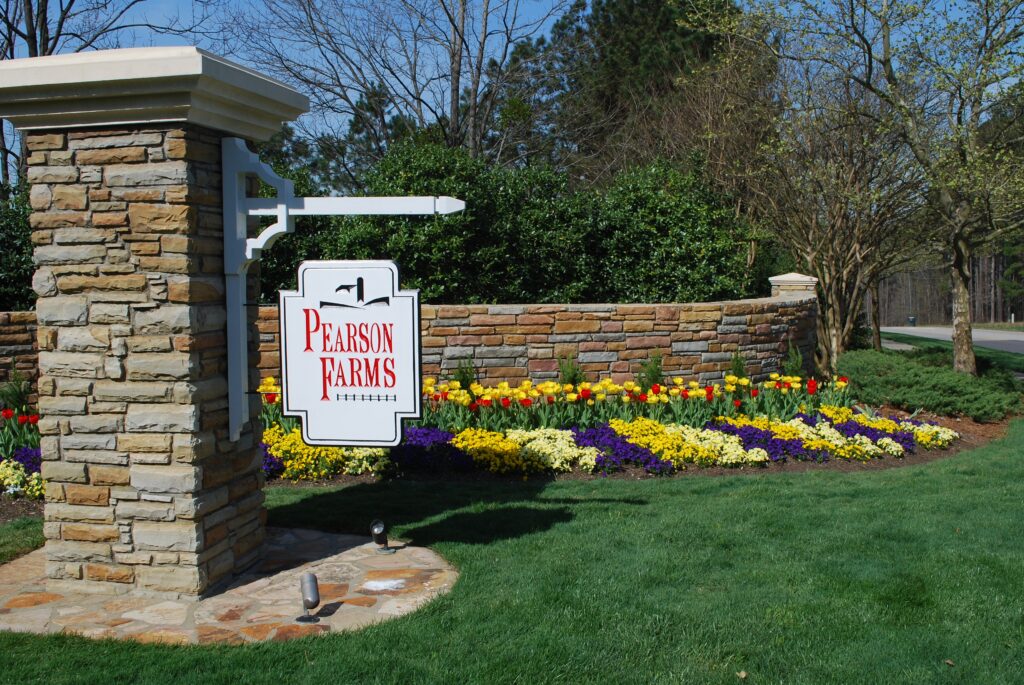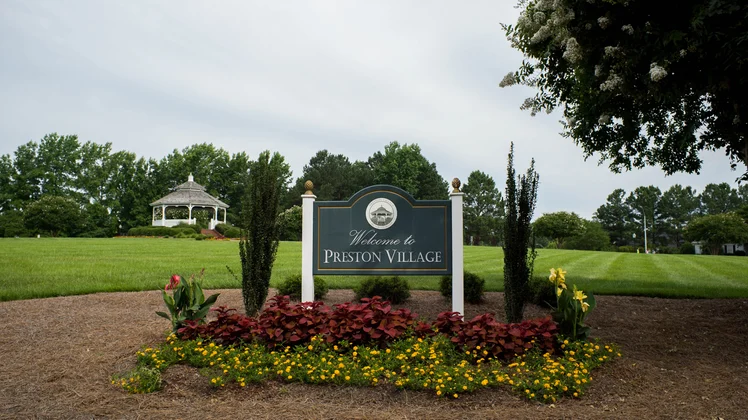If you manage a commercial property, chances are there’s a sign out there somewhere under your care.
But does anybody notice it?
Not if it’s dragged down by straggly grass, faded mulch and outdated junipers from a decade or two ago.
“Your signage is the only way for people to realize you’re there,” says Tyler Read, a client relations manager at Greenscape, Inc. “It’s the first impression people get of you.
“If there’s no landscaping, people might not even want to peer into your parking lot,” Read says. “But if there’s a nice tree and some beautiful purple flowers, maybe a water feature, chances are they’re going to want to go in and see what other beautiful things are there.”
Stick with Read. He has all kinds of landscaping ideas for business signs – and he answers all your questions here.
What will Draw the Most Attention to my Sign?
“This is one of the questions I get asked most often,” Read says. “I love using bright, popping colors.” Flowers in vivid purples and pinks always grab the eye, he says.
“Dwarf crape myrtle is one of my favorites,” he says. “It’s very hardy and comes in a ton of colors.”
It stays compact, too, which is a good trait in signage landscape plants. While it only gets about two feet high, it has a full, luxurious look.

The right ground cover matters, too, Read says. Opt for decorative stone to pack the biggest punch.
“A lot of business owners choose lava rock or black rocks,” he says. “Those just fade into the background.”
Aging, faded mulch? Get it out of there. It’s a terrible first impression.
For a more updated look, Read likes a bed of decorative stone with pockets of plants, European style, for depth and a more modern look.
Why do I Need to Change the Landscaping Twice a Year?
Flowering annuals, a signage landscaping staple, aren’t meant to last a whole year. That’s why Greenscape crews change them seasonally, so your landscaping always looks fresh and appealing.
This seasonal rotation includes flowers for beds and pots in the spring to last through the warm months, and a second batch of fall flowers to freshen up beds and planters when the summer blooms have faded.
How can my Signage Look Great in Winter, Too?
Our winters here in North Carolina are short, but drab. So Read chooses background plants that stay green and appealing all year long, like a variety of holly plants.
“Hollies hold onto that emerald green,” he says.
What about juniper? Yawn.
“I’m not big on juniper,” Read says. “It looks kind of dated.”
He loves using daffodils and tulips in the spring — the perfect cheerful welcome to greet your visitors.
“They really pop in the landscape,” he says. “And they let you know that it IS spring.”
Why can’t you Plant my Favorite Plants by my Sign?
Maybe we can, Read says. But if the environment isn’t right for your favorite plants, we’d be wasting your money.
“It can be a difficult conversation if a customer really wants a plant that just won’t do well on the site,” he says.
Is your heart set on a certain pink flowering plant?
Maybe it needs sun, but your sign is in shade. Maybe it needs a lot of water, but your site doesn’t have irrigation. Maybe the soil around your sign is too acidic.
But don’t worry. Read’s on it.
“Chances are, we can suggest three other pink flowering plants that will do better with your amount of sunlight and your amount of water,” Read says. “That’s what we do.”
What are the Best Plants to use around Signage?
This is the fun part. Read has a few favorites — tried and true plants that look great, attract attention and are hardy enough to thrive in the often difficult conditions that exist in landscaping around signage.
Among his go-to signage plants:
Loropetalum
This stunner, also known as Chinese fringe-flower, has long, thin petals on its fringe-like blooms. Read loves it for its vibrant purple leaves and hot pink or fuchsia flowers.
“It’s also very hardy,” he says. “It can grow into a shrub line, if you like, but it won’t get wild and out of control.” His favorite varieties are ‘China red’ and ‘Ruby red.’
Yaupon Holly
The bright red berries of the female plant offer a cheerful pop of color to the winter landscape.
“They grow together well if you want a hedge, or you can grow them as individual spheres,” Read says.
Jasmine
This is a Read go-to for ground cover. Low growing, it won’t obscure signage lettering. This vining evergreen boasts glossy leaves and small, fragrant white, yellow or pink flowers.
Azaleas
This might be everybody’s favorite.
“It has great colors and variety,” Read says. These popular flowering shrubs produce vibrant blooms that last for several weeks. If you have trees near your signage, azaleas don’t mind sharing the spot.
Dwarf Crape Myrtle
This mini version of the popular Southern tree offers a cascade of brilliant flowers, but has a compact habit and disease resistant foliage. Bonus: it’s drought tolerant when established.
Why do you Choose the Plants you do?
Well, lots of reasons, including some Read has already mentioned, like light, soil and water conditions.
But a main reason is you don’t want your signage landscaping to overtake your sign.
That means selecting low growing and slow growing plants that know how to lay low.

“The lettering on commercial signs is usually just two to three feet above ground,” Read says. “If a plant grows to four feet high at maturity, it’s a constant battle to keep it low enough. You have to choose the right plant variety so its mature height is below the sight line.”
Remember, too, that the concrete and blacktop near most commercial signs radiate a lot of heat, making it a pretty harsh environment. Your landscaping needs to stand up to the challenge.
What’s one thing I can do for Better Sign Landscaping?
Add irrigation, Read says.
“Irrigating the area around your sign allows you a lot more plant choices,” Read says. “That also allows for grass to grow, if that’s important to you.”
More and more, new commercial properties are including irrigation systems, he says.
“Otherwise, you have to pay a watering service,” he says, which costs $60 to $70 a visit.
“If you install irrigation in an existing property, it’s a bit of an investment upfront, because you have to cut through concrete and close down a traffic lane during installation,” Read says, “but it’s worth it in the long run. Your maintenance costs go down.”
What Kind of Maintenance can I Expect?
The plants we install around signage are pretty hardy, by design, Read says, but they will need occasional maintenance.
Pruning is important for plant health, both to keep plants from obstructing your sign’s lettering and for periodic rejuvenation.
Regular fertilizing will keep plants happy and healthy.
“Plants love nitrates,” Read says. “We’ll put iron in the soil for nice green color. “
Greenscape crews also keep an eye out for signs of damaging insects, fungus and other diseases.
Why does the Grass around my Sign Look Terrible?
“This is probably the question I get the most,” Read says.
If your grass shares the space with a big tree or trees, there’s your answer, he says. Trees, with their extensive root systems, are stealing all the water.
Chances, are, there’s concrete or blacktop nearby too, which radiate a lot of damaging heat.
And if you don’t have an irrigation system pumping out water, your grass is just plain parched.
“The thing is, that won’t change,” Read says.

“A nice patch of green grass, nicely clipped, looks really pleasing. But if it’s brown and dried out, it looks the exact opposite. You’ll have a constant battle if you try to keep it green.”
Are there other options? You bet.
Mondo grass is a great lawn substitute. An evergreen perennial, it’s a slow-growing grass-like plant that thrives in almost any soil and lighting condition.
Read also loves liriope as a lawn alternative, especially the ‘Big Blue’ variety. The grass-like foliage is tufted and arching and attractive on its own. For extra fun, it sports pretty blue flower spikes.
If you want really low maintenance, replace that straggly patch of lawn with river rock, mulch or pine straw, Read says.
“That gives a clean, pleasing look, with low maintenance.”
I Love Roses. Why are you Shaking your Head?
Who doesn’t love roses? But they may not be the best choice for your signage landscaping.
Roses typically need frequent deadheading to produce new blooms.
And the latest rose disease, rose rosette, is slowly destroying even roses that have been bred to be disease resistant, like the Knock Out variety.
Once it hits a bush, “it can spread to your entire row of roses,” Read says. “The only way to treat them is to rip them out.”
Landscaping Around Signage? At Greenscape, We’re Experts
“If your signage area is beautiful, clean, and well organized, that says your business is, too,” Read says.
Trust the experts at Greenscape, Inc. to create a signage area that can’t be missed, with landscaping ideas for business signs tailored to your property’s unique needs.
We’ve been meeting the full-service landscaping needs of commercial customers in the Raleigh, Durham, Chapel Hill and Cary areas for more than 35 years.
We offer landscape management and lawn care, design and build services, irrigation, landscape lighting and more.
Call us at 919-552-7742 or fill out our online form to request a free consultation and learn how we can transform your landscape.
We can’t wait to hear from you.
